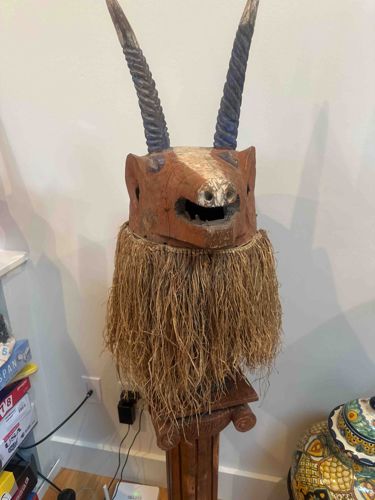
African Tribal Mask (Likishi/Pwo style)
This appears to be an African tribal mask, likely originating from a Central or West African culture, possibly a 'Likishi' type mask used by the Chokwe people or a similar style. The mask depicts an animalistic face, possibly a warthog or a stylized antelope/boar, carved from natural wood. Its primary colors are an aged reddish-brown for most of the face, contrasted with a white or off-white pigment outlining the snout and forehead, consistent with traditional tribal aesthetics. The mask features two prominent, spiraled horns, dark gray or black in color with hints of a bluish tint, which are attached to the top of the head. These horns exhibit a textured, ridged surface. The snout is deeply carved with an open mouth displaying a rough, uneven edge, and two distinct nostrils are visible on the top of the snout. Small ear-like protrusions are present on either side of the head. A substantial beard or mane made of natural, dried fibers (possibly raffia or similar plant material) is attached below the face, hanging down to cover the chin and neck area. The fibers are a light golden-brown color and appear aged. The overall construction suggests hand-carving, with visible tool marks contributing to its rustic and authentic appearance. The wood shows signs of age, including minor cracks, surface wear, and a rich patina that indicates significant use or display over time. There are no obvious maker's marks or signatures visible from the provided images. The mask is mounted on what appears to be a carved wooden stand or pedestal, which is also reddish-brown and exhibits classic column-like detailing with scrolls at the base of the mask, suggesting it is part of a complete display piece. The style points towards traditional ceremonial or cultural art, likely from the early to mid-20th century or possibly older, depending on further verification of its provenance. The craftsmanship is robust and functional, typical of items made for cultural practices rather than purely decorative purposes. The condition appears stable, with wear consistent with its age and intended use or display.
AI-Generated Appraisal Disclaimer
Estimated Value
$600-1,200
Basic Information
Category
Tribal Art and Artifacts
Appraised On
December 7, 2025
Estimated Value
$600-1,200
Item Description
This appears to be an African tribal mask, likely originating from a Central or West African culture, possibly a 'Likishi' type mask used by the Chokwe people or a similar style. The mask depicts an animalistic face, possibly a warthog or a stylized antelope/boar, carved from natural wood. Its primary colors are an aged reddish-brown for most of the face, contrasted with a white or off-white pigment outlining the snout and forehead, consistent with traditional tribal aesthetics. The mask features two prominent, spiraled horns, dark gray or black in color with hints of a bluish tint, which are attached to the top of the head. These horns exhibit a textured, ridged surface. The snout is deeply carved with an open mouth displaying a rough, uneven edge, and two distinct nostrils are visible on the top of the snout. Small ear-like protrusions are present on either side of the head. A substantial beard or mane made of natural, dried fibers (possibly raffia or similar plant material) is attached below the face, hanging down to cover the chin and neck area. The fibers are a light golden-brown color and appear aged. The overall construction suggests hand-carving, with visible tool marks contributing to its rustic and authentic appearance. The wood shows signs of age, including minor cracks, surface wear, and a rich patina that indicates significant use or display over time. There are no obvious maker's marks or signatures visible from the provided images. The mask is mounted on what appears to be a carved wooden stand or pedestal, which is also reddish-brown and exhibits classic column-like detailing with scrolls at the base of the mask, suggesting it is part of a complete display piece. The style points towards traditional ceremonial or cultural art, likely from the early to mid-20th century or possibly older, depending on further verification of its provenance. The craftsmanship is robust and functional, typical of items made for cultural practices rather than purely decorative purposes. The condition appears stable, with wear consistent with its age and intended use or display.
Related Tags
Get Your Items Appraised
Instant estimates of your treasures with AI-powered instant appraisals